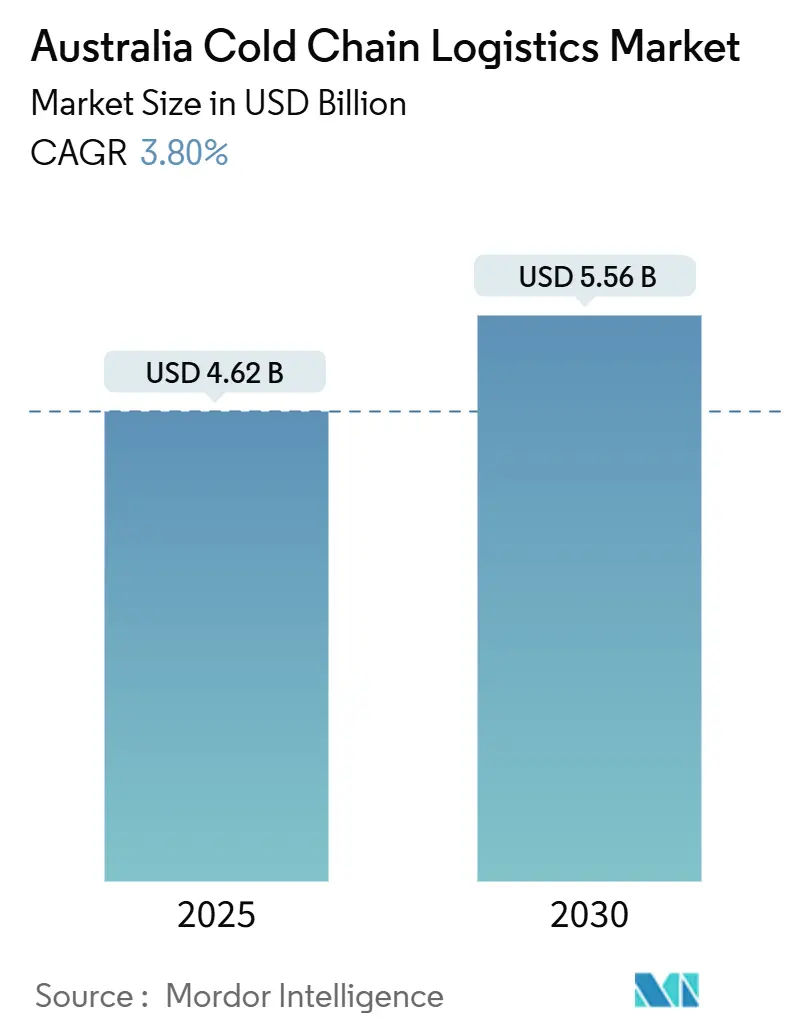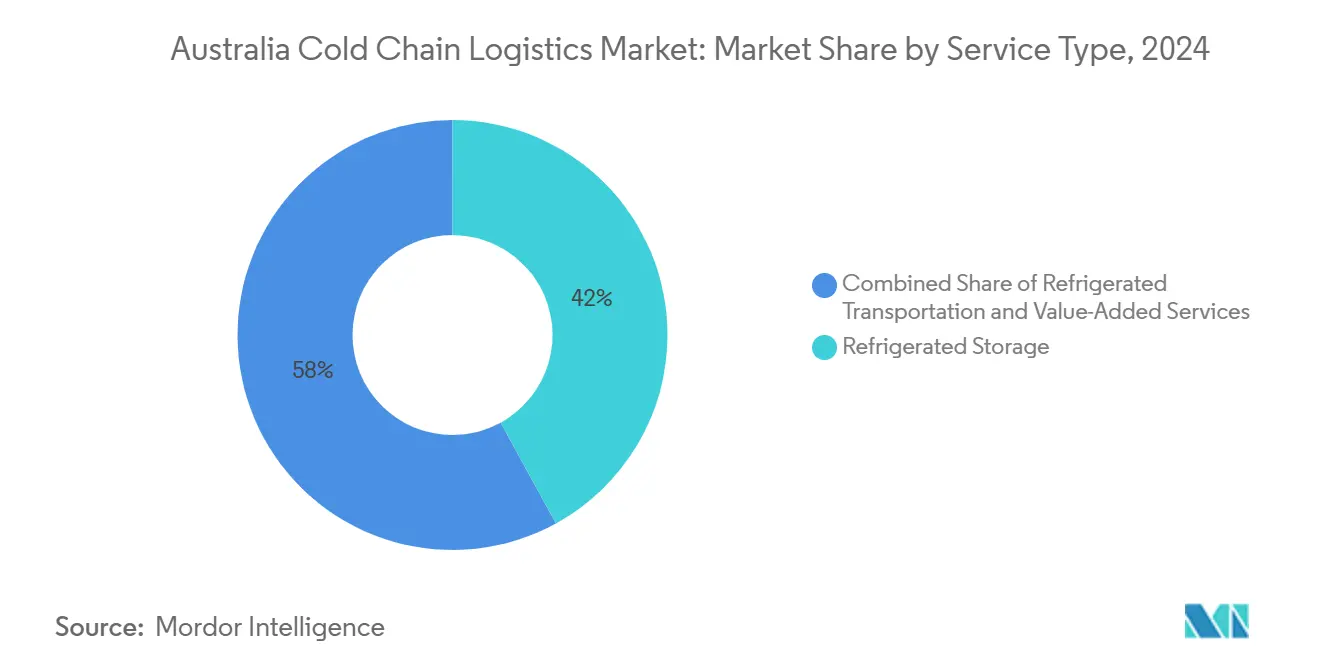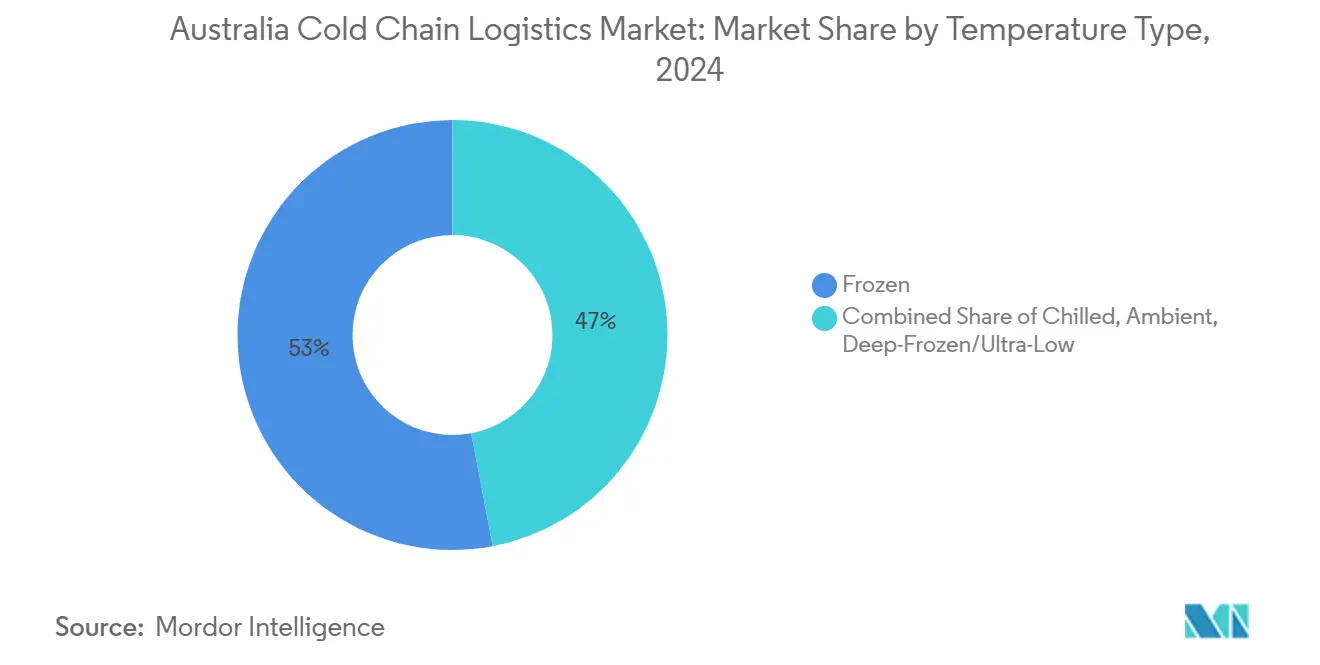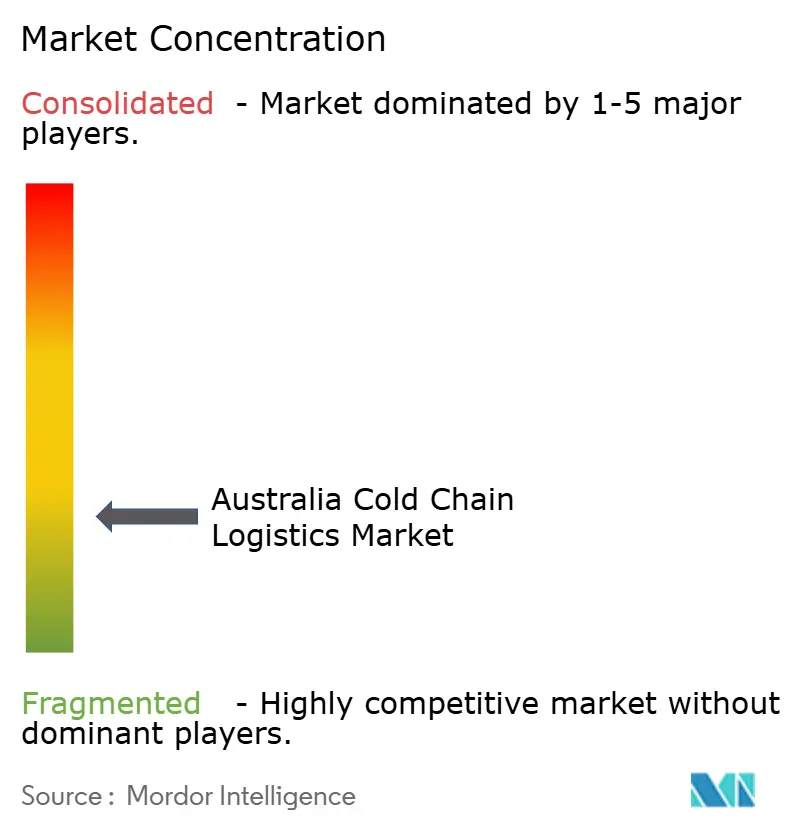
Australia Cold Chain Logistics Market Analysis by Mordor Intelligence
The Australia Cold Chain Logistics Market size is estimated at USD 4.62 billion in 2025, and is expected to reach USD 5.56 billion by 2030, at a CAGR of 3.80% during the forecast period (2025-2030).
Surging e-commerce grocery volumes, expanding pharmaceutical cold storage demand, and infrastructure upgrades driven by net-zero mandates are shaping short and long-term growth trajectories. Rising private-equity activity is unlocking build-to-suit capacity as industrial vacancy tightens below 1% in Sydney and Melbourne. High electricity prices, refrigerant phase-outs, and a scarcity of modern freezer space weigh on margins but simultaneously accelerate investment in renewable power and low-GWP systems. Federal export-hub grants are funneling capital toward regional storage nodes that support the nation’s USD 4.8 billion sheep-meat export economy[1]“Transition Assistance Package,” Department of Agriculture, AGRICULTURE.GOV.AU. Consolidation among warehouse operators and fleets is enabling nationwide temperature-controlled networks that meet increasingly stringent product-integrity requirements.
Key Report Takeaways
- By service type, Refrigerated Storage led with 42% of Cold chain logistics Australia market share in 2024, while Value-Added Services is forecast to expand at a 4.55% CAGR to 2030.
- By temperature type, Frozen applications commanded 53% share of the Cold chain logistics Australia market size in 2024, whereas Deep-Frozen/Ultra-Low storage is advancing at a 4.1% CAGR through 2030.
- By application, Meat & Poultry held 24% share of the Cold chain logistics Australia market size in 2024 and Ready-to-Eat Meals is rising at a 5.3% CAGR to 2030.
Australia Cold Chain Logistics Market Trends and Insights
Drivers Impact Analysis
| Driver | (%) Impact on CAGR Forecast | Geographic Relevance | Impact Timeline |
|---|---|---|---|
| E-commerce grocery boom | +0.8% | Sydney, Melbourne urban cores | Medium term (2-4 years) |
| Pharma and biologics pipeline expansion | +0.6% | National hubs | Long term (≥4 years) |
| Federal export-hub grants | +0.4% | Regional export corridors | Short term (≤2 years) |
| REIT capital inflow amid <1% vacancy | +0.5% | Sydney, Melbourne, Brisbane | Medium term (2-4 years) |
| Net-zero mandates for low-GWP refrigerants | +0.3% | National priority centers | Long term (≥4 years) |
| Private-equity roll-ups | +0.4% | Nationwide | Medium term (2-4 years) |
| Source: Mordor Intelligence | |||
E-commerce grocery boom accelerating last-mile refrigerated logistics
Growing online grocery penetration is re-drawing distribution footprints. Retailers such as Coles invested USD 1 billion in automated centers that process 4 million cartons weekly across multi-temperature zones, lowering manual handling and shrinkage. Woolworths sources 96% of fresh produce domestically, intensifying demand for chilled facilities proximate to metropolitan customers. Voice-directed picking devices engineered for –30 °C improve order accuracy and reduce turnover in harsh storage environments. Transport, Postal and Warehousing job postings surged 41% year-on-year in Sydney during 2024, reflecting last-mile fulfillment momentum. This activity underpins consistent throughput for road, rail, and air fleets within the Cold chain logistics Australia market.
Pharma & biologics pipeline expansion raising ultra-cold storage needs
DHL has earmarked EUR 2 billion (USD 2.20 billion) by 2030 for GDP-certified hubs and temperature-controlled vehicles, signalling sustained life-science demand. Baxter Healthcare’s Western Sydney facility upgrade adds 20 million IV bags of annual capacity, requiring stringent 2 °C to 8 °C storage to protect product efficacy. Toll Group’s 10,000 sqm healthcare warehouse in Tullamarine supports CSL Seqirus vaccine manufacturing with –20 °C zones and dedicated quality labs. Rising biologics pipelines are boosting the Deep-Frozen/Ultra-Low sub-segment’s 4.1% CAGR and reinforcing the Cold chain logistics Australia market as a strategic enabler for sovereign medicine supply. Integration of BICON with customs systems further reduces temperature-excursion risk by streamlining import clearance for sensitive therapies[2]“Export Registered Fish Storage Establishments,” Department of Agriculture, Fisheries and Forestry, DAFF.GOV.AU.
Federal export-hub grants for agri-food cold chain infrastructure
A USD 139.7 million transition assistance package channels USD 40 million toward agri-food processing and storage upgrades, strengthening domestic value-addition and export competitiveness. Fish storage facilities spanning Fremantle to Brisbane form a distributed network that supports Australia’s export-oriented seafood sector[3]“Freight Policy Reform Consultation Report,” NSW Government, TRANSPORT.NSW.GOV.AU. Protocol markets mandate cold treatment and accredited packhouses for table grapes, prompting investment in blast-coolers and real-time temperature monitoring. The Food Safety and Growth Initiative offsets up to 50% of equipment costs for small processors, accelerating regional cold chain modernization. Collectively, these incentives enhance resilience and reach of the Cold chain logistics Australia market.
Real-estate REIT capital inflow amid less than 1% vacancy unlocking build-to-suit capacity
Lineage Logistics’ USD 5 billion IPO in 2024 created the world’s largest temperature-controlled warehouse REIT, fuelling further Australian expansion. Brookfield’s AUD 1.25 billion (USD 850.68 million) portfolio reached 90% occupancy, emphasizing infill estates tailored for last-mile distribution. Goodman Group’s AUD 78.7 billion (USD 53.55 billion) portfolio maintains 97.7% occupancy, and 2.9 million sqm of new industrial supply scheduled for 2025 remains pre-leased due to unmet demand. Prime Sydney rents rose 16% year-over-year, encouraging speculative build-to-suit projects with multi-temperature flexibility. These dynamics inject fresh capacity into the Cold chain logistics Australia market while supporting resilience amid space scarcity.
Restraints Impact Analysis
| Restraint | (%) Impact on CAGR Forecast | Geographic Relevance | Impact Timeline |
|---|---|---|---|
| High electricity prices and carbon pricing | –0.7% | National manufacturing hubs | Short term (≤2 years) |
| Shortage of grade-A freezer space | –0.5% | Sydney, Melbourne, Brisbane | Medium term (2-4 years) |
| Costly refrigerant phase-outs | –0.4% | National commercial refrigeration | Short term (≤2 years) |
| Scarcity of certified refrigeration technicians | –0.3% | National, regional skills gaps | Long term (≥4 years) |
| Source: Mordor Intelligence | |||
High electricity prices and carbon pricing inflating opex
Wholesale gas and power prices have tripled since 2022, imposing acute cost pressure on energy-intensive cold storage operations. Some plastics and fertilizer plants shuttered in 2024, underlining the threat to high-consumption sites. Operators retrofit LED lighting, high-speed doors, and thermal insulation but face capital constraints and protracted paybacks. CSIRO’s GenCost report warns that integration costs for variable renewables further complicate energy planning. Solar-equipped roofs at Coles’ new facilities illustrate a pathway to hedge tariff volatility. Despite mitigation, energy remains the largest controllable expense within the Cold chain logistics Australia market over the near term.
Severe shortage of modern grade-A freezer space in tier-1 metros
Sydney’s industrial land scarcity forces tenants like Aldi to wait more than two years for suitable freezer capacity near Western Sydney airport, driving rents to USD 271 per sqm. National vacancy sits at 2.5%, with pre-leasing absorbing much of the 2.3 million sqm new supply expected in 2025. Many upcoming projects cater to dry logistics, not specialized –25 °C facilities. Consequently, chilled inventories endure longer haul distances, elevating spoilage risk. Developers are pivoting to multi-story cold stores, yet high construction costs restrain build pace. This bottleneck limits potential throughput for the Cold chain logistics Australia market until new space enters service.
Segment Analysis
By Service Type: Value-added services drive premium growth
Refrigerated Storage maintained 42% of Cold chain logistics Australia market share in 2024, underscoring its foundational role. Public warehousing models let smaller producers access certified temperature zones without heavy capital outlays. Private warehousing supports retailers requiring bespoke handling protocols, and Americold’s USD 36 million Sydney build-out will add 2.8 million cu ft to meet anchor-tenant grocery demand. Value-Added Services such as kitting, labeling, and repacking command higher margins, and their 4.55% CAGR through 2030 indicates shippers’ shift toward integrated solutions.
Refrigerated Transportation spans road, rail, sea, and air, with Toll Group’s USD 67 million battery-electric fleet investment illustrating decarbonization intent. Cross-docking and synchronized inventory programs shorten dwell time, freeing capacity for high-velocity SKUs. Voice-directed workflow adoption exceeds global benchmarks, enhancing labor productivity and reducing errors in sub-zero environments. As service portfolios deepen, the Cold chain logistics Australia market increases its resilience and pricing power.

Note: Segment shares of all individual segments available upon report purchase
By Temperature Type: Deep-frozen applications gain pharmaceutical momentum
Frozen storage held 53% share of the Cold chain logistics Australia market in 2024, serving meat, seafood, and dairy chains. Chilled ranges at 0–5 °C support fresh produce, with Woolworths’ domestic sourcing reinforcing metro-proximate capacity. Ambient zones act as buffers for staging mixed-temperature orders in automated centers.
Deep-Frozen/Ultra-Low rooms below –20 °C record a 4.1% CAGR, lifted by biologics and mRNA vaccine requirements. Baxter and CSL Seqirus expansions demand redundant power and real-time monitoring to guard against thermal excursions. Operators retrofit racking to support product at -40°C, and CO₂ cascade systems offset energy penalties. These advances fortify the pharmaceutical share of the Cold chain logistics Australia market size and foster high-value service niches.

Note: Segment shares of all individual segments available upon report purchase
By Application: Ready-to-eat meals accelerate amid convenience trends
Meat & Poultry held 24% share of Cold chain logistics Australia market size in 2024, buoyed by domestic processing after live-export phase-outs and resilient export volumes. Fish & Seafood leverage a network of export-registered stores that streamline port operations. Fruits & Vegetables rely on post-harvest cold treatment compliance to access premium protocol markets, reinforcing the need for packhouse accreditation.
Ready-to-Eat Meals segment grows at 5.3% CAGR, reflecting convenience preferences fueled by remote work and smaller household sizes. Meal-kit platforms and quick-commerce grocers require dense urban micro-fulfillment hubs with strict two-hour pick-to-ship windows. Pharmaceuticals & Biologics sustain deep-frozen capacity utilization, and specialized tracking supports chain-of-custody audits for clinical trial materials. Collectively these dynamics diversify demand and broaden revenue streams within the Cold chain logistics Australia market.
Geography Analysis
New South Wales and Victoria combined generated roughly 65% of Cold chain logistics Australia market revenue in 2024 and are forecast to expand at a 3.9% CAGR through 2030[4] “Lineage Logistics – Fremantle Coldstores,” Australian Competition and Consumer Commission, ACCC.GOV.AU. Sydney’s industrial land scarcity inflates rents and drives multistory development, while Melbourne benefits from agri-food clusters and port connectivity. Brisbane capitalizes on proximity to Asia-Pacific trade lanes, attracting export-oriented freezer projects.
Western Australia and South Australia post 3.2% and 2.8% CAGR respectively, supported by mining-camp catering contracts and horticulture exports via Fremantle and Adelaide ports. Queensland’s tropical climate keeps year-round demand steady for chilled storage, serving large tourism flows. The Northern Territory and Tasmania remain smaller but specialized, focusing on remote community provisioning and premium seafood exports.
Federal freight policy reforms integrate cold chain considerations into road, rail, and port planning, ensuring that future corridors include power capacity for refrigerated nodes. Distributed networks reduce backhaul empty runs and improve shelf life across vast distances. Geography therefore shapes cost structures and strategic placement of assets throughout the Cold chain logistics Australia market.
Competitive Landscape
The Australia Cold chain logistics market is moderately fragmented. Lineage Logistics’ acquisition of Fremantle City Coldstores grew its national footprint to 13 sites, while Americold advances through greenfield builds near population centers. Golden West and NewCold pursue automated high-bay designs that cut labor by up to 60%.
Technology adoption differentiates competitors. Automated storage and retrieval systems, voice-guided picking, and IoT temperature probes yield measurable cost savings. Toll Group’s AUD 267 million (USD 181.07 million) fleet modernization aligns with retailer sustainability targets and bolsters long-haul reliability. Emerging players harness cloud-based visibility platforms that provide SKU-level temperature traceability, appealing to pharmaceutical clients.
Regulatory shifts toward low-GWP refrigerants and strict export protocols favor operators with capital access and compliance expertise. Private equity accelerates consolidation, extracting synergies and standardizing service levels nationwide. Niche specialists remain viable where ultra-low storage or regional distribution expertise commands price premiums. Competitive dynamics therefore blend scale advantages with specialized competencies across the Cold chain logistics Australia market.
Australia Cold Chain Logistics Industry Leaders
-
NewCold Advanced Cold Logistics
-
Karras Cold Logistics
-
Toll Group
-
Linfox
-
Lineage Logistics
- *Disclaimer: Major Players sorted in no particular order



Recent Industry Developments
- November 2024: Toll Group invested USD 67 million in 28 battery-electric heavy vehicles and 30 chargers, targeting a 1,810 tonne annual CO₂ cut.
- October 2024: Lineage Logistics finalized acquisition of Fremantle City Coldstores, marking 13 domestic facilities.
- October 2024: Lindsay Australia joined RWTA, expanding cold chain coverage across five states
- October 2024: Toll Group announced USD 200 million fleet upgrade adding nearly 400 Euro 6 prime movers.
Australia Cold Chain Logistics Market Report Scope
A cold chain is a temperature-controlled supply chain. Cold chain logistics is the technology and process that allows the safe transport of temperature-sensitive goods and products along the supply chain. A complete background analysis of the Australia Cold Chain Logistics Market, including the assessment of the economy and contribution of sectors in the economy, market overview, market size estimation for key segments, and emerging trends in the market segments, market dynamics, and geographical trends, and COVID-19 impact is included in the report.
The Australia cold chain logistics market is segmented by service (storage, transportation, and value-added services), temperature type (chilled and frozen), and application (fruits and vegetables, dairy products, meat and seafood, processed food, pharmaceuticals (include biopharma), bakery and confectionery, and other applications). The report offers market sizes and forecasts in values (USD billion) for all the above segments.
| Refrigerated Storage | Public Warehousing |
| Private Warehousing | |
| Refrigerated Transportation | Road |
| Rail | |
| Sea | |
| Air | |
| Value-Added Services |
| Chilled (0-5°C) |
| Frozen (-18-0°C) |
| Ambient |
| Deep-Frozen / Ultra-Low (less than-20°C) |
| Fruits and Vegetables |
| Meat and Poultry |
| Fish and Seafood |
| Dairy and Frozen Desserts |
| Bakery and Confectionery |
| Ready-to-Eat Meals |
| Pharmaceuticals and Biologics |
| Vaccines and Clinical Trial Materials |
| Chemicals and Specialty Materials |
| Other Perishables |
| By Service Type | Refrigerated Storage | Public Warehousing |
| Private Warehousing | ||
| Refrigerated Transportation | Road | |
| Rail | ||
| Sea | ||
| Air | ||
| Value-Added Services | ||
| By Temperature Type | Chilled (0-5°C) | |
| Frozen (-18-0°C) | ||
| Ambient | ||
| Deep-Frozen / Ultra-Low (less than-20°C) | ||
| By Application | Fruits and Vegetables | |
| Meat and Poultry | ||
| Fish and Seafood | ||
| Dairy and Frozen Desserts | ||
| Bakery and Confectionery | ||
| Ready-to-Eat Meals | ||
| Pharmaceuticals and Biologics | ||
| Vaccines and Clinical Trial Materials | ||
| Chemicals and Specialty Materials | ||
| Other Perishables | ||


Key Questions Answered in the Report
What is the current value of the Cold chain logistics Australia market?
The Cold chain logistics Australia market size stood at USD 4.62 billion in 2025.
How fast will the sector grow through 2030?
Market value is projected to rise to USD 5.56 billion by 2030 at a 3.8% CAGR.
Which service segment shows the fastest expansion?
Value-Added Services lead growth with a 4.55% CAGR thanks to demand for labeling, kitting, and inventory controls.
Why are deep-frozen facilities gaining attention?
Rising biologics and mRNA vaccine production needs ultra-low storage below –20 °C, driving a 4.1% CAGR in this sub-segment.
How are electricity costs influencing strategy?
Tripled power prices prompt operators to adopt solar roofs, airtight construction, and low-GWP refrigerants to curb operating expenses.
What level of market concentration exists among providers?
The top 10 firms control about 35% of revenue, reflecting moderate concentration with ongoing consolidation activity.
Page last updated on:








